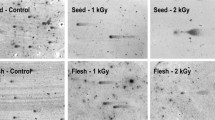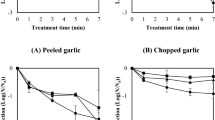Abstract
Seeds and cereal grains can be treated with low energy (<300 keV) or high energy (1–10 MeV) electrons for decontamination of phytopathogenic and spoilage organisms. In this preliminary study, maize samples were treated with low energy electrons of 125 keV or high energy electrons of 10 MeV. To identify the electron treatment different detection methods were investigated: photostimulated luminescence (PSL), thermoluminescence (TL), and DNA Comet Assay. These three methods are already standardised at a European level and have now been adopted as general Codex methods for detection of irradiated foodstuffs. The results suggest that the PSL and TL methods are most suitable for detection of electron-treated maize. The DNA Comet Assay was able to detect treatment of maize with high energy electrons for some samples, but could not detect treatment with low energy electrons.
Zusammenfassung
Saatgut und Getreide kann mit niederenergetischen Elektronen (<300 keV) oder hochenergetischen Elektronen (1–10 MeV) wirksam behandelt werden, um Mikroorganismen und Insekten abzutöten. In dieser vorläufigen Studie wurde Mais mit niederenergetischen (125 keV) und hochenergetischen Elektronen (10 MeV) behandelt. Um diese Elektronenbehandlung nachzuweisen, wurden verschiedene Verfahren eingesetzt: Photostimulierte Lumineszenz (PSL), Thermolumineszenz (TL) und DNA-Kometentest. Für diese drei Nachweismethoden existieren bereits Europäische Normen und sie sind als „Allgemeine Codex Methoden“ zum Nachweis bestrahlter Lebensmittel etabliert. Die Ergebnisse zeigen, dass PSL und TL geeignete Verfahren sind, um sowohl eine Behandlung von Mais mit niederenergetischen als auch mit hochenergetischen Elektronen zu erkennen. Der DNA-Kometentest erwies sich als weniger geeignet: die Behandlung mit niederenergetischen Elektronen konnte—wie erwartet—nicht nachgewiesen werden. Die Behandlung mit hochenergetischen Elektronen konnte bei einer Maissorte erkannt werden, jedoch nicht bei einer anderen Sorte.



Similar content being viewed by others
References
Ahmed M (2001) Disinfestation of stored grains, pulses, dried fruits and nuts, and other dried foods. In: Molins RA (ed) Food irradiation: principles and applications. Wiley, New York, pp 77–112
ASTM E 1026 (1995) Standard practice for using the Fricke reference standard dosimetry system. In: ASTM International (ed), Annual Book of ASTM Standards 2002 (12.02), West Conshohocken, Pa., pp 526–532
Beer H, Ellner F, Jahn M, Schiemann J (1995) Alternative methods of integrated pest management. Brighton Crop Protection 1995, Supplement 6:26–28
Buhl C, Weidener H, Zogg H (1975) Krankheiten und Schädlinge an Getreide und Mais. Verlag Eugen Ulmer, Stuttgart
Burth U, Jahn M, Lindner K (1992) Seed treatment with electrons—an alternative process for seed dressing. Schriftenreihe der Deutschen Phytomedizinischen Geselschaft (4). Proceedings of the 10th International Symposium on Systemic Fungicides and Antifungal Compounds, pp 273–279
Cutrubinis M, Delincée H, Stahl M, Röder O, Schaller HJ (2005) Detection methods for cereal grains treated with low and high energy electrons. Radiat Phys Chem 72:639–644
Delincée H, Khan AA, Cerda H (2003) Some limitations of the Comet Assay to detect the treatment of seeds with ionising radiation. Eur Food Res Technol 216:343–346
EN 1788 (2001) Foodstuffs—thermoluminescence detection of irradiated food from which silicate minerals can be isolated. European Committee of Standardisation, Brussels
EN 13751 (2002) Foodstuffs—Detection of irradiated food using photostimulated luminescence. European Committee of Standardisation, Brussels
EN 13784 (2001) Foodstuffs—DNA Comet Assay for the detection of irradiated foodstuffs—screening method. European Committee of Standardisation, Brussels
Fuchs E, Grüntzig M, Kuntze L (1994) Viruskrankheiten im Mais, jetzt auch in Deutschland. Mais 22:140–143
Hayashi T, Takahashi Y, Todoriki S (1997) Low-energy electron effects on the sterility and viscosity of grains. J Food Sci 62:858–860
Hayashi T, Okadome H, Toyoshima H, Todoriki S, Ohtsubo K’I (1998a) Rheological properties and lipid oxidation of rice decontaminated with low-energy electrons. J Food Prot 61:73–77
Hayashi T, Takahashi Y, Todoriki S (1998b) Sterilization of foods with low energy electrons („soft electrons“). Radiat Phys Chem 52:73–76
Heitefuss R, König K, Obst A, Reschke M (1993) Pflanzenkrankheiten und Schädlinge im Ackerbau (3 edn). DLG-Verlag, Frankfurt
ISO/ASTM 51275 (2002) Standard practice for use of radichromic film dosimetry system. In: ASTM International (ed) Annual book of ASTM standards 2002 (12.02), West Conshohocken, Pa., pp 926–930
Kim C-K, Yang J-S, Lee H-J (1999) Detection of irradiated grains using the DNA ‚Comet Assay’. Korean J Food Sci Technol 31:906–911
Lindner K, Röder O (1998) A new non-chemical method—seed treatment with electrons. In: Abstracts of the 25th International Seed Testing Congress—Seed Symposium, Pretoria, 15–24 April 1998, pp 38–39
Salimov RA, Cherepkov VG, Kuksanov NK, Kuznetzov SA (2000) The use of electron accelerators for radiation disinfestation of grain. Radiat Phys Chem 57:625–627
Schröder T, Röder O, Lindner K (1998) e-dressing—a unique technology for seed. ISTA News Bulletin 118:13–15
Todoriki S, Hayashi T (1999) DNA comet assay for rice seeds treated with low energy electrons („soft electrons“). Food Irradiat Jpn 34:9–15
Yi S-D, Yang J-S (2000) The application of a pulsed photostimulated luminescence (PPSL) method for the detection of irradiated foodstuffs. J Food Sci Nutr 5:136–141
Acknowledgements
The authors would like to thank Mrs. Sigrid Delincée, Ms. Susanne Vollmer and Mr. Michael Knörr for their technical assistance.
Author information
Authors and Affiliations
Corresponding author
Rights and permissions
About this article
Cite this article
Cutrubinis, M., Delincée, H., Stahl, M. et al. Preliminary results on detection of maize treated with electrons for seed dressing and according decontamination and infestation. Gesunde Pflanzen 57, 129–136 (2005). https://doi.org/10.1007/s10343-005-0074-y
Received:
Accepted:
Published:
Issue Date:
DOI: https://doi.org/10.1007/s10343-005-0074-y
Keywords
- Seed dressing
- Cereals
- Maize
- Electron treatment detection
- Low energy electrons
- e-Ventus
- High energy electrons
- Photostimulated luminescence
- Thermoluminescence
- DNA comet assay




